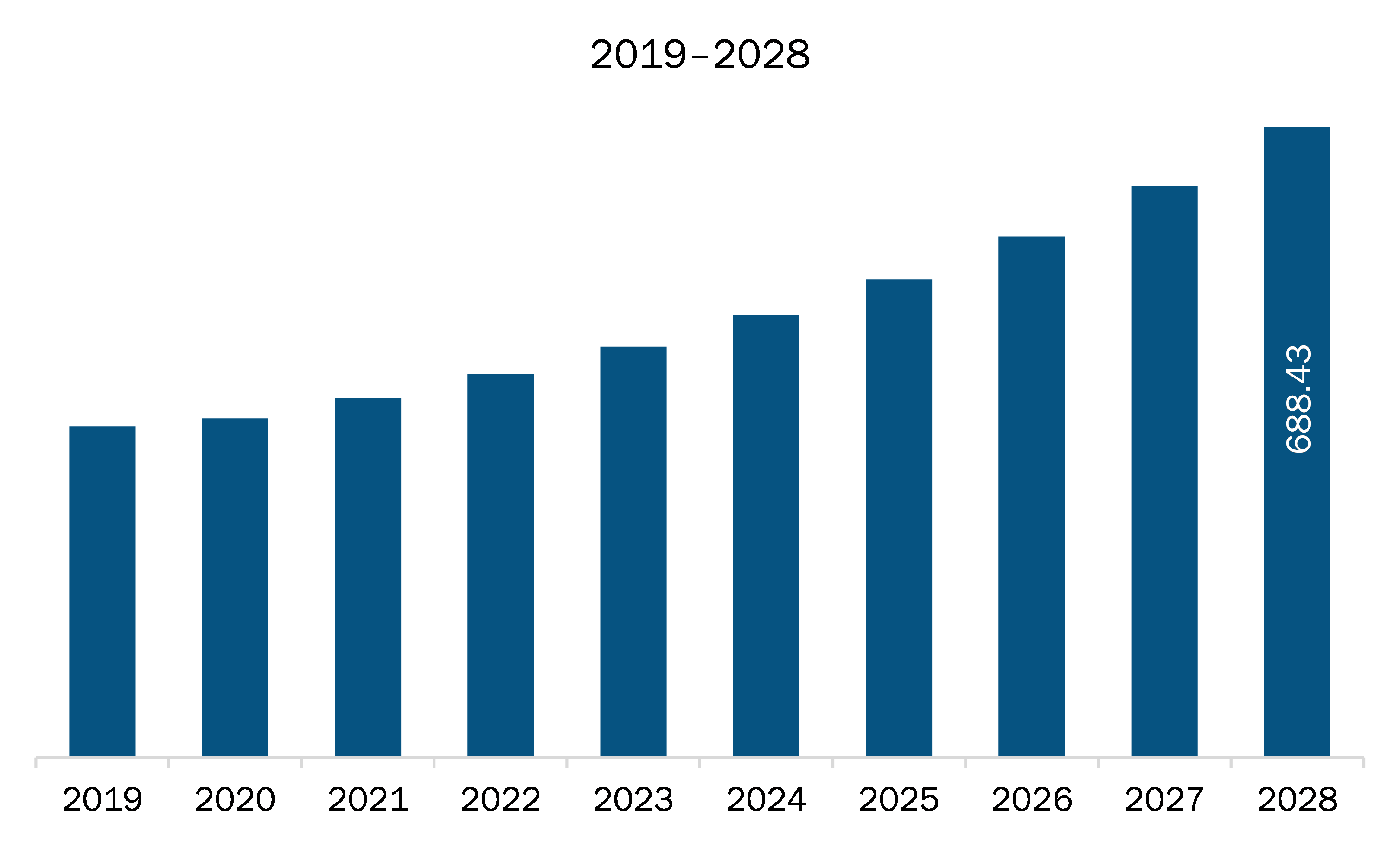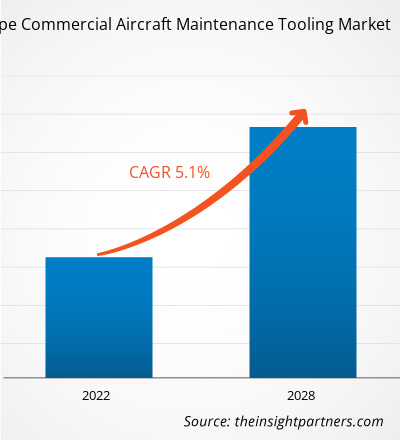The Europe commercial aircraft maintenance tooling market is expected to grow from US$ 424.10 million in 2021 to US$ 601.97 million by 2028; it is estimated to grow at a CAGR of 5.1% from 2021 to 2028.
The aviation industry is highly regulated and requires precise monitoring for safer operations. The airlines and commercial aircraft OEMs require continuous inspection and checking of aircraft for maintaining the guidelines made by aviation authorities. The modern aircraft models require regular check & maintenance of parts and different components to preserve the life span as long as possible along with safer and efficient operations. Also, different commercial aircraft components require common maintenance tools and specific tools to perform maintenance, repair, and overhaul operations. Therefore, the maintenance tools play an important role in retaining the life span of an aircraft and support the airlines, aircraft OEMs, and MRO service providers to retain efficient operations that also lead to better aircraft performance. Moreover, the rising awareness for predictive aircraft maintenance is one of the major trends propelling the demand for aircraft maintenance worldwide across the aviation sector. In addition, the deployment of new technologies in commercial aircraft and demand for refurbishment of old generation commercial aircraft fleet are expected to drive the demand for commercial aircraft maintenance tooling in the near future. The European commercial aviation stakeholders experienced havoc tremors from the COVID-19 pandemic. Several aircraft maintenance tooling market players experienced cancellation of previous orders, which reflected a downturn in their revenues, thereby negatively impacting the market. Nonetheless, as the airlines are bringing back their fleets into service, the demand for maintenance tooling is rising at a decent rate, which is a positive growth factor for the commercial aircraft maintenance tooling market players. The need for maintenance tooling is growing in Europe at a fair pace in the current scenario, as the stored aircraft fleet requires intense maintenance. On the other hand, from an aircraft production and delivery perspective, Airbus, the largest commercial aircraft manufacturer, experienced a significant decline in production volumes in 2020. However, as domestic and international aviation is picking up, the aircraft manufacture intends to scale up its production of the A320 fleet. Thus, with the increase in the newer fleet, the adoption rate of different maintenance tools is expected to rise in the coming years.
With the new advancements and technologies, vendors can attract new customers and expand their footprints in emerging markets. This factor is likely to drive the Europe commercial aircraft maintenance tooling market. The commercial aviation industry had been witnessing a significant growth rate prior to the outbreak of COVID-19. However, the concerns related to vibrations on aircraft engines and airframes are among the most critical aspects for MRO service providers and airline operators with in-house MRO facility looks upon. This is due to the fact that more than any other industry, each component in the aviation industry is mission-critical as a single defect has the potential of causing costly or catastrophic consequences. Therefore, engine and airframe vibration analysis are of utmost importance for the aircraft operators and MRO service providers, which is propelling the demand for vibration meters in the MRO industry stakeholders, bolstering the commercial aircraft maintenance tooling market.
Europe Commercial Aircraft Maintenance Tooling Market Revenue and Forecast to 2028 (US$ Million)

- This FREE sample will include data analysis, ranging from market trends to estimates and forecasts.
Europe Commercial Aircraft Maintenance Tooling Market Segmentation
Europe Commercial Aircraft Maintenance Tooling Market – By Tool Type
- Speed Handle
- Wrenches
- Safety Wire Pliers
- Vibration Meters
- Metal Working Tools
- NDT Tools
- Others
Europe Commercial Aircraft Maintenance Tooling Market – By Users
- MRO Service Providers
- Airline Operator
Europe Commercial Aircraft Maintenance Tooling Market – By Application
- Engine
- Airframe
- Landing Gear
- Line Maintenance
- Others
Europe Commercial Aircraft Maintenance Tooling Market – By Country
- France
- Germany
- Italy
- UK
- Russia
- Rest of Europe
Europe Commercial Aircraft Maintenance Tooling Report Scope
| Report Attribute | Details |
|---|---|
| Market size in 2021 | US$ 424.10 Million |
| Market Size by 2028 | US$ 601.97 Million |
| Global CAGR (2021 - 2028) | 5.1% |
| Historical Data | 2019-2020 |
| Forecast period | 2022-2028 |
| Segments Covered |
By Tool Type
|
| Regions and Countries Covered | Europe
|
| Market leaders and key company profiles |
- Historical Analysis (2 Years), Base Year, Forecast (7 Years) with CAGR
- PEST and SWOT Analysis
- Market Size Value / Volume - Global, Regional, Country
- Industry and Competitive Landscape
- Excel Dataset


- Parking Management Market
- Arterial Blood Gas Kits Market
- Environmental Consulting Service Market
- Europe Tortilla Market
- Energy Recovery Ventilator Market
- Retinal Imaging Devices Market
- Virtual Pipeline Systems Market
- Medical Enzyme Technology Market
- Latent TB Detection Market
- Microplate Reader Market

Report Coverage
Revenue forecast, Company Analysis, Industry landscape, Growth factors, and Trends

Segment Covered
This text is related
to segments covered.

Regional Scope
North America, Europe, Asia Pacific, Middle East & Africa, South & Central America

Country Scope
This text is related
to country scope.
Trends and growth analysis reports related to Aerospace and Defense : READ MORE..
- HYDRO SYSTEMS KG
- Red Box Aviation
- Stanley Black & Decker, Inc.
- STAHLWILLE Eduard Wille GmbH & Co. KG
- Field International Group Limited
- Henchman Products
- Dedienne Aerospace
- Franke Aerotec GmbH
- Tronair Inc.
- Snap-On Incorporated

 Get Free Sample For
Get Free Sample For